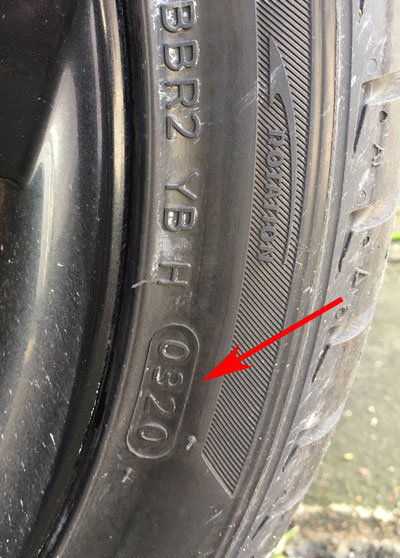In Part One of this post, we looked at why the law was changed to make old tyres illegal on certain types of vehicle, then made the case for extending that to cars.
This time, as promised, we’ll be focusing on:
- the likely penalties for driving with old tyres
- why low-mileage drivers are even more at risk from ageing tyres
- how you can check the age of your tyres.
The penalties for old tyres
According to the Government’s website, the new law will only apply to certain vehicles. Specifically:
the front wheels of lorries, buses and coaches, and all wheels of minibuses
Looking at current tyre laws, the penalties for breaking the new law could be severe. At the moment, motorists who drive with defective tyres face a maximum of penalty of £2500 and three points on their licence per tyre. So, a motorist driving with four defective tyres could incur an eye-watering £10,000 fine and 12 points – enough to lose their licence.
Obviously, we won’t know what the new penalties will be until the law is enacted, but we wouldn’t be surprised if it followed the same penalty structure.
None of this will apply to car drivers, although again, we wouldn’t be surprised if it is gradually rolled out to include passenger vehicles (and we think that it should be).
However, the real penalty for anyone driving on an old tyre isn’t what the courts could throw at you. The laws of physics are far more unforgiving and could result in death or serious injury for someone.
One real problem is that old tyres are a much less visible issue than bald or damaged ones. And in our view, there’s one type of motorist who is particularly vulnerable: low mileage drivers.
Low mileage drivers and old tyres
At first sight, it would seem obvious that the lower your annual mileage, the less you need to worry about old tyres. But it’s more complicated than that.
During the March 2020 lockdown, most of us were turned into low-mileage drivers, at least temporarily. If you didn’t take the car out for a few weeks, you might have noticed something strange in your first drive, something not quite right.
The ride may have felt rougher and noisier, and the car more unpredictable on corners. If so, that was probably due to flat spots developing when the car was standing. These usually disappear as the tyre warms up and returns to its proper shape, with no harm done. However, flat spots show us just how much stress tyres are under when they’re inactive.
Here’s why. When tyres are rotating, waxy compounds within them are activated. These are designed to slow down oxidation – the ageing process that stiffens tyres and introduces crazing to the sidewalls. When a tyre is stationary for an extended period, tyres lose this protection. They dry out and age faster.
Applying this to infrequent drivers, the problem is that there can be plenty of tread on the tyre, but inactivity has left it prematurely aged. It’s therefore even more important for occasional or low-mileage drivers to keep an eye on the age of their tyres.
Which begs the question – how do you check your tyre’s age?
How to check the age of your tyres
Fortunately, checking the age of your tyres is pretty simple. It’s right there on the tyre in a four digit code. The first minute of this video explains it nicely.
 Essentially, the first two digits tell you what week the tyre was manufactured and the last two tell you the year. For example, 0320 denotes a tyre that was manufactured in the third week of 2020. Easy!
Essentially, the first two digits tell you what week the tyre was manufactured and the last two tell you the year. For example, 0320 denotes a tyre that was manufactured in the third week of 2020. Easy!
If you encounter a tyre with just three digits, alarm bells should start ringing — it means the tyre was made before 2000 and therefore needs replacing.
If you’re uncertain whether a tyre needs replacing, check with a tyre specialist (like us!!)
The BK Tyres blog carries news, views and information on tyres and related subjects. BK Tyres supplies and fits tyres throughout South Oxfordshire, including the communities of Abingdon, Didcot and Henley on Thames. As an independent, family run mobile provider, we provide exceptional levels of service and affordable prices. Contact us today.
